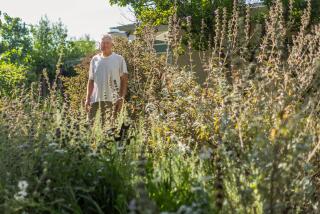Claude Hope; Brought Impatiens to Gardens
- Share via
If you have ever puttered in a garden, chances are you have knelt over the colorful and profuse legacy of a man named Claude Hope.
Hope, who died July 14 at his home in Cartaga, Costa Rica, was a horticultural legend: He was the father of the impatiens, long the No. 1 bedding plant in the United States. He was 93.
He discovered the lankier forebear of the shade-loving, profusely blooming garden staple in the wilds of Costa Rica in the 1940s, when he was posted there by the U.S. Army. Charmed at first sight, he saw the plant’s potential and set out to develop a dwarf version suitable for the garden.
His strain, called Elfin, was an instant winner when it hit the North American market in the late 1960s. Almost every one of the hundreds of varieties of impatiens on the market today is a descendant of Hope’s hybrid.
What Hope did was “tantamount to going to Africa, finding a small cat and then creating the house cats that we all live with,” said Michael MacCaskey of the Burlington, Vt.-based National Gardening Assn. “In Costa Rica, you see impatiens everywhere. It’s like this weed. He tamed it.”
That Hope would be drawn to garden flowers as a boy seemed improbable even to him. He grew up on a hardscrabble West Texas dairy farm: “Not very helpful in ornamental horticulture,” he remarked to an interviewer some years ago.
Yet he was curious about blooms at an age when many boys are more inclined toward mud and rocks. His passion grew into a major in ornamental horticulture at Texas Tech University in Lubbock. He graduated in 1929, then worked at a U.S. Department of Agriculture field station in Arizona, where he helped breed fungus-resistant cotton. He later worked at a federal plant research center in Maryland, where he evaluated many varieties of ornamental seed and, in 1939, earned a master’s degree at Michigan State University.
In 1941, he was drafted into the army and eventually dispatched to Costa Rica, where his job was to grow Cinchona ledgerana, a source of a critical ingredient of quinine, the anti-malaria medicine vital to troop health in the Pacific theater.
During a walk in the countryside, he became enchanted with a vigorous growth about three feet high of a plant dotted with sparse but colorful flowers. It was impatiens. Hope was determined to transform this virtual jungle weed into a shorter breed with more abundant blooms.
After completing his military service, he moved to Costa Rica and started the Pan American Seed Co. in 1946 with W.D. Holley and Charles Weddle. (The company was sold in 1981 to its largest customer, Geo. J. Ball Inc. of West Chicago, Ill.) In 1953, he founded a seed farm called Linda Vista. He worked on hybridizing impatiens, eventually developing a dwarf series that bloomed like crazy and was easy to grow from seed.
He sent samples to Purdue and Michigan State universities for testing. By 1969, his Elfin impatiens was introduced to rave reviews in the U.S.
By luck of timing, it appeared on the market as many suburban gardens were maturing, creating swaths of dreaded shade. When nurseries began to sell Hope’s brightly hued Elfin, the serious gardener, who had had few options beyond enduring drab splotches of plant-killing darkness, suddenly could paint in them. The advent of the impatiens, MacCaskey said, “made a new kind of style possible: color in shade.”
Impatiens quickly pushed past petunias, geraniums and marigolds as the American gardener’s bedding plant of choice. So many other breeders eventually leaped on the low-growing plant that now there are more than 1,000 varieties.
It is so common nowadays that, as Times Garden Editor Robert Smaus recently noted, it is “perhaps the most loved, and hated, of flowers. . . . Some serious gardeners wouldn’t plant one if their horticultural life depended on it because they’re so common.”
Hope never married but had, by all accounts, a large and devoted adopted family--his 1,000 employees at the Costa Rica seed farm. A generous mentor, he provided horticultural training to all his workers, promoting to manager many who started with him as teenagers. He awarded college scholarships and established a trust fund to make long-term home loans. His humanitarian business practices brought him honors from the Costa Rican government and civic groups.
Over his six decades in horticulture, Hope developed many other plants, including a red petunia called Comanche, a form of the Texas bluebell called Blue Lisa and two popular strains of coleus. Productive until his last years, he recently introduced a variety of the annual abutilon noted for its upright, hibiscus-like flowers.
Yet the impatiens remained his favorite.
“I am very fond of impatiens,” Hope said in 1992, when he received the American Horticultural Society’s highest honor, the Liberty Hyde Bailey Award. “But I would have never guessed that it would become our most popular bedding plant.”
More to Read
Sign up for Essential California
The most important California stories and recommendations in your inbox every morning.
You may occasionally receive promotional content from the Los Angeles Times.













